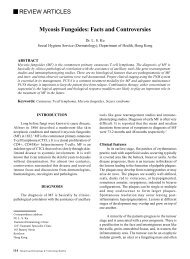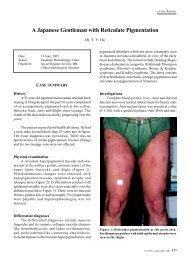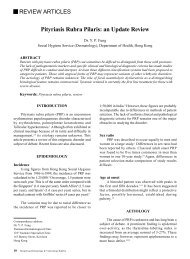How I treat small earlobe keloids with intralesional cryosurgery
How I treat small earlobe keloids with intralesional cryosurgery
How I treat small earlobe keloids with intralesional cryosurgery
You also want an ePaper? Increase the reach of your titles
YUMPU automatically turns print PDFs into web optimized ePapers that Google loves.
eyond it. The stylet is then removed. The hub of<br />
the cannula is then connected to the cryogun outlet<br />
by screwing tight. The cryogun should be kept in<br />
an upright position <strong>with</strong>out much tilting. Now start<br />
to spray liquid nitrogen. The cannula would<br />
gradually coat <strong>with</strong> white flakes due to formation<br />
of ice. Further continuous spraying produces<br />
freezing of the keloid and eventually formation of<br />
an 'ice ball'. After keeping the freezing for some<br />
seconds, stop spraying liquid nitrogen and let the<br />
'ice ball' to thaw until the cannula can be loosened<br />
and be removed <strong>with</strong> ease. The overall single<br />
<strong>treat</strong>ment time for one keloid may take few<br />
minutes.<br />
Erythema, mild oozing and sometimes crusting<br />
may occur. Patient is discharged <strong>with</strong> mild<br />
analgesic and 1:2000 aqueous chlorhexidine for<br />
daily dressing if required. Follow-up assessment<br />
and further <strong>cryosurgery</strong> may be contemplated if<br />
appropriate.<br />
Figures 1 to 3 depict the procedure and clinical<br />
progress in a Chinese teenage girl <strong>with</strong> right<br />
postauricular keloid not responsive to <strong>intralesional</strong><br />
<strong>How</strong> I <strong>treat</strong> <strong>small</strong> <strong>earlobe</strong> <strong>keloids</strong> <strong>with</strong> ILC 19<br />
steroid injections. An 'ice ball' is created upon<br />
prolonged liquid nitrogen spray (Figure 1). Figure 2<br />
shows clinical progress at Week 0, Week 4, Week<br />
6 and Week 8. A total of two <strong>treat</strong>ments were<br />
given in Week 0 and Week 4. Figure 3 shows the<br />
changes in keloidal volume represented graphically.<br />
A continuing diminution of volume was noted and<br />
reached to 9 mm 3 at Week 24. To facilitate<br />
prolonged cryospraying, a nylon zip tie fastened<br />
around the cryogun and pressing tightly on the<br />
spray button ameliorates hand fatigue (Figure 4).<br />
Figure 1. Freezing of keloid to an 'ice ball'.<br />
Figure 2. Clinical progress.






